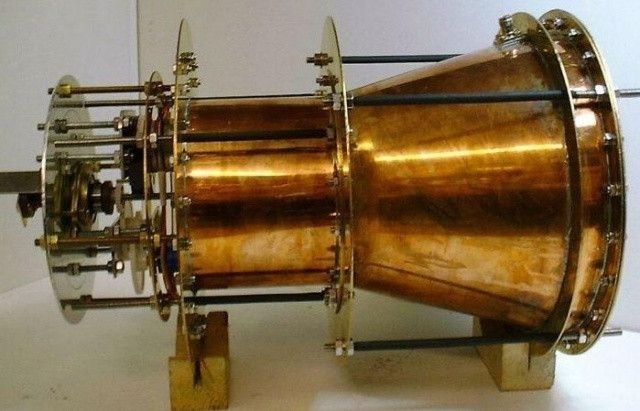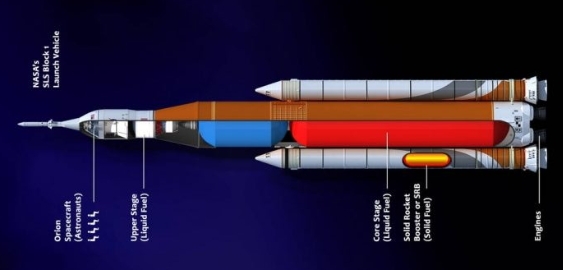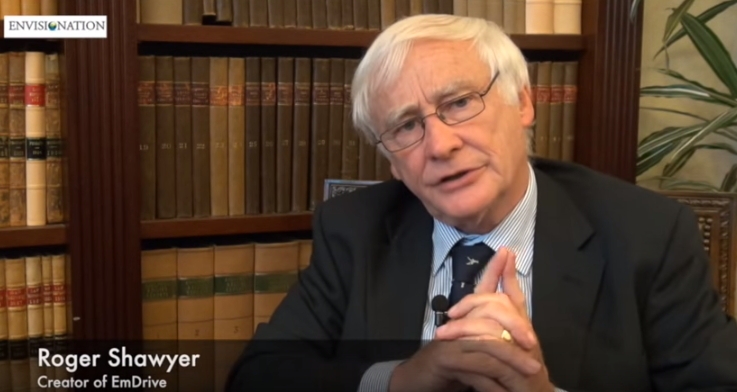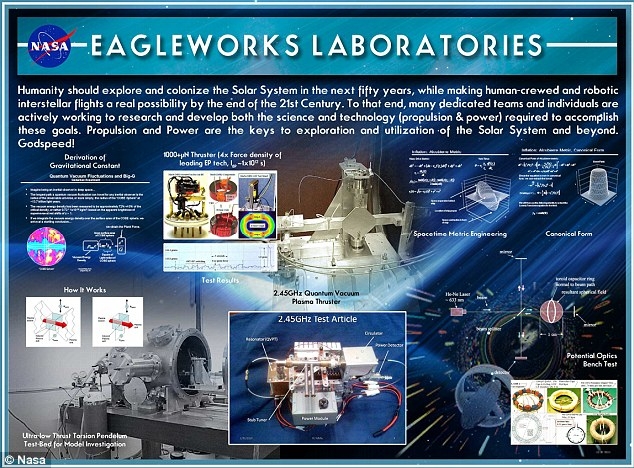In 10 weeks, I sent people to Mars' EmDrive engine. Was Civilian, Shenqi or Century Discovery?

Whether it is ordinary people or scientists, it seems that one can see the ridiculousness behind EmDrive. However, the results of the experiment make people once again widen their eyes.
According to the "Daily Mail" report, after several years of "retreat" research, NASA finally published a paper on EmDrive. It is reported that the paper has passed the peer review stage. A mainstream academic journal has accepted the application for publication of the paper. In the next few days, we will see the results of NASA's mysterious research for several years.
EmDrive is an exception in the scientific community. It is a violation of the classic physics and is easily regarded as a laughing folk.
However, for more than a decade, EmDrive has not slipped into the dust, but has caused more and more attention. Because authorities such as NASA can't deny the experimental results it produces. What's even more puzzling is that no one knows how it works so far, and even its inventor Roger Shawyer cannot explain it clearly.
This reminds people of the scene in science fiction novelist Asimov’s “End of Eternityâ€: Future humans traveled through time and sent a man named Vico Marranson to the 21st century to create technology that surpassed the technology of the day. Horizontal machine. There is a paragraph describing Maranson in the book:
“ His colleagues often feel very annoyed because he can create such a magical machine but cannot explain the principle . â€
This is similar to what happened to EmDrive's inventor Roger Shawyer.
| EmDrive: engine without fuelEmDrive's full name is Electromagnetic Drive. Its core component is a specially shaped microwave resonant cavity. The constantly jumping microwaves provide thrust for the spacecraft. Solar energy can provide electricity to maintain the movement of the microwave.
Roger Shawyer called it "a rocket engine without exhaust ." This means that it is a rocket engine without fuel.

EmDrive Prototype, from: The Wired
If it can become a reality, it will have an unparalleled impact on the entire aerospace industry. Because the spacecraft at this stage needs to carry a large amount of heavy fuel to fly into outer space, the fuel is gone and the spacecraft can no longer operate.
Take the SLS rocket prepared by NASA for the Mars tour as an example. It needs to send the top-level Orion capsule to outer space. However, as shown in the figure below, the volume and quality of the entire rocket are most red and blue. Liquid fuel tanks.

EmDrive does not require any such fuel. The core component that generates thrust is a vacuum chamber, which is incredibly light compared to conventional fuel tanks.
Only solar energy is needed. It can accumulate speed slowly in outer space and eventually fly to the outer planet with extreme speed. It is estimated that if EmDrive is used as the engine of a spacecraft, then it will only take 4 hours to travel to the moon, 10 weeks to Mars, and only 100 years to Centauri (the technology needs tens of thousands of years at this stage).
However, EmDrive has been questioned because it seems to violate Newton's third law.
| EmDrive violates the laws of classical physics?Newton's third law is this:
When two objects interact, the forces exerted on each other are equal in magnitude and in opposite directions. "Force" will inevitably appear in pairs to the ground: One of the forces is called "force"; the other is called "reaction."

To launch the rocket, it is necessary to generate propulsion. The way to generate propulsion is to burn the liquid fuel inside the rocket. The ejected gas will exert an upward reaction force on the rocket. This thrust will lift the rocket.
However, the outside world of EmDrive did not have any force, but it was out of nowhere.
Roger Shawyer was also asked about this "eternal" question in an interview. He clearly stated that EmDrive did not violate Newton's laws of mechanics, but the reason for explanation was rather vague. He said:
"EmDrive is based on Newton's third law of motion. EmDrive generates propulsion in one direction and accelerates in the opposite direction if possible. The momentum throughout the process is conserved." (EmDrive produces thrust in one direction.) , and if it's allowed to, it will accelerate in the opposite direction. Momentum is conserved by this process.)
He said that EmDrive is based on the theory of Maxwell, Newton and Einstein, and there is no other unique theory.

Roger Shawyer for an interview
Although Roger Shawyer established Satellite Propulsion Research in the United Kingdom in 2001 and is committed to the research of EmDrive, Lei Fengnet (searching for the "Lei Feng Net" public number concerned) did not find the company's website, but only found a very simple provision of EmDrive. Web page of relevant information.
| NASA ground-breaking resultsShawyer conducted an experiment in 2003 and said that the results of the experiment showed a slight 16-milli-million propulsion, equivalent to the weight of two peanuts. However, he did not publish peer-reviewed academic papers (or rather, no chance to publish).
In 2006, an American engineer named Guido Fetta made a prototype modeled after EmDrive called "Cannae Drive." He also did not publish a paper.
On September 8, 2006, New Scientist, the old British scientific journal, chose to use EmDrive as a cover. The related articles published believed that the device appeared to be credible. Subsequently, science fiction writer Greg Egan published an open letter stating that the article “seeks to sensationalism and the author lacks basic scientific knowledge.†Greg Egan’s article was forwarded on the American blog by John C. Baez, a math physicist in the United States. New Scientist promptly issued a clarification statement, accompanied by an open letter from experts who expressed negative opinions on EmDrive.
It is generally believed that EmDrive is just like a perpetual motion machine and lacks the support of scientific principles and cannot be realized.
By this time, perhaps we can also laugh at EmDrive as a civilian program until a group of scientists in China began to pull EmDrive into the formal academic circle.
Since 2010, Prof. Yang Wei of Northwestern University has published a paper on EmDrive. In 2013, she led a team, produced the EmDrive prototype, and published a paper (Chinese) to publish the test results: 2.5 kilowatts of electricity generated 720 millinewtons (about 72 grams) of propulsion . Someone translated the papers of Yang Lan into English and spread it in the media and academic circles.
In August 2013, NASA had a research team focused on thruster devices, called “Eagleworks,†who conducted two Cannae Drives at the Lyndon B. Johnson Space Center in Texas. The eight-day experiment was conducted and, on June 4, 2014, the results of the experiment were published in the form of papers at the 50th Joint Promotion Meeting of the American Institute of Aeronautics and Astronautics (AIAA). Experimental data showed that under the stimulation of 28 watts of electricity, a thrust of 30-50 micron (1 millinewton = 1000 micron) was produced.

Picture from: NASA
The results of this test were extremely shocking. Originally, everyone was waiting for NASA's rumor. I did not expect it to be such a result, which was far beyond people's expectations. This time, EmDrive fired, major mainstream media rushed to report, and several weeks of heading to Mars took over the day's tech news headlines.
Shawyer himself also began to have the opportunity to speak and publish papers at the Toronto Space Conference in October 2014.
NASA then experimented with Shawyer's EmDrive prototype in the summer of 2014 and early 2015, and measured 50 micron of propulsive power at 50 watts of power. In July 2015, Prof. Martin Tajmar of the Dresden University of Technology in Germany presented his more sophisticated experimental results to EmDrive at the AIAA's Advancement and Energy Forum, and proved that it can indeed produce propulsion.
By this time, there were experimental data from two authoritative organizations, NASA and Dresden University of Technology. People could no longer look at EmDrive in the civilian sector. Even though no one has been able to give a rational explanation of the underlying principles.
At the same time, the storytelling and astonishing potential use of EmDrive's "Counterattack" aroused the interest of ordinary people, and the production of EmDrive does not require complicated devices. On YouTube, there are many science lovers who have uploaded their own productions. Small EmDrive experiment video.
| Might be behind the principle: no one knows, can only guessFirst, Shawyer himself did not give a convincing explanation of the principle. NASA’s 2014 paper also made it clear that it does not elaborate on the principle of this machine, but simply provides experimental data.
The rumors of the EmDrive are likely to be Warp Drives in science fiction works such as Star Trek. Its principle is super-light travel, which generates propulsion by changing the time before and after the engine. This is, of course, the most pleasing assumption for sci-fi movie fans, but it has been negated by a number of researchers, including Shawyer himself, who explicitly stated in the interview that he was "not a Warp Drive."

The more reliable guess is that EmDrive is actually driven by the virtual particles of the quantum vacuum. The virtual particles are present in the world for a short period of time, and they continue to emerge and quickly disappear. Therefore, the vacuum is not a vacuum. But this is just a guess.
As for the paper that will be published by NASA this time, the news came from Dr. José Rodal of the Nasa Spaceflight Forum. He said in the post:
“My personal understanding is that Eagleworks' new paper has been accepted by academic journals and will be published soon. Note: I did not hear this from any NASA employee.â€
He also clearly stated the topic of the paper and suggested that this academic journal is likely to be owned by AIAA.
In March of this year, Paul March, an engineer at the Eagleworks Laboratory, also confirmed that EmDrive was being reviewed by peers but said that the process was very slow.
Although Dr. José Rodal has made it clear that his message does not come from NASA employees, there is still a large number of mainstream foreign media coverage of this news, people are happy to see the interpretation of the principle of the mysterious EmDrive, because it is indeed too fantastic.
Source (Science Internet, click to get):
 Daily Mail ;
 Video interviewed by Roger Shawyer ;
The Satellite Propulsion Research company website established by Roger Shawyer;
NASA's paper at the AIAA 50th Joint Promotion Conference;
Roger Shawyer's PPT at the Toronto Space Conference in October 2014;
Dr. José Rodal, who broke the news, stated that NASA’s possible paper title is: Measurement of Impulsive Thrust from a Closed Radio Frequency Cavity in Vacuum.
Extended reading:
After landing the moon for a while, I will catch an asteroid. What is NASA doing to emigrate Mars?
Big Airbus Group's big idea: flying taxi, do you dare to sit?
"Space UAE": The two companies want to change the asteroids to printing machines (I)
APM 75V rack mount DC Power Supply is applicable for activation of some electronic devices in military field. Comparing with other variable power supply in the market, APM supports a most complete array of interfaces, including USB, LAN, RS232, RS485, analog control interface, GPIB (option).
Master/Slave Series/Parallel operation mode for up to 10 units, which allow a more flexible and convenient use of the variable AC Power Supply.It also provides built-in standard automobile electrical testing curves,users can select any built-in curve to do the DUT performance test directly according to their demand.
Some features of the power supply as below:
- Ultrafast respond time and high efficiency.
- Accurate voltage and current measurement capability
- Constant Power and wide range of voltage and current output
- Equips with LIST waveform editing function
- Compliant with SCPI communication protocol
- Full protection: OVP/OCP/OPP/OTP/SCP
- Voltage drop compensation by remote sense line.
- Have obtained CE,UL,CSA,FCC.ROHS
75V DC Power Supply,Programmable DC Power Supply,Variable Power Supply,Regulated Power Supply
APM Technologies Ltd , https://www.apmpowersupply.com